Ford Mustang 2019 Owners Manual

2019 MUSTANG Owner’s Manual
MUSTANG2019
owner.ford.com |
ford.ca |
Manual Owner’s
May 2018
First Printing
Litho in U.S.A.
KR3J 19A321 AA
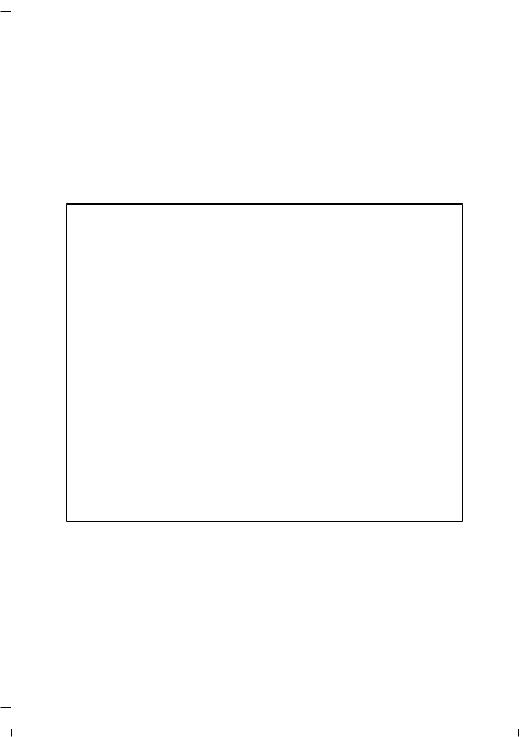
The information contained in this publication was correct at the time of going to print. In the interest of continuous development, we reserve the right to change specifications, design or equipment at any time without notice or obligation. No part of this publication may be reproduced, transmitted, stored in a retrieval system or translated into any language in any form by any means without our written permission. Errors and omissions excepted.
© Ford Motor Company 2018
All rights reserved.
Part Number: 201804 20180403181258
California Proposition 65
 WARNING: Operating, servicing and maintaining a passenger vehicle or off-highway motor vehicle can expose you to chemicals including engine exhaust, carbon monoxide, phthalates, and lead, which are known to the State of California to cause cancer and birth defects or other reproductive harm. To minimize exposure, avoid breathing exhaust, do not idle the engine except as necessary, service your vehicle in a well-ventilated area and wear gloves or wash your hands frequently when servicing your vehicle. For more information go to www.P65Warnings.ca.gov/passenger-vehicle.
WARNING: Operating, servicing and maintaining a passenger vehicle or off-highway motor vehicle can expose you to chemicals including engine exhaust, carbon monoxide, phthalates, and lead, which are known to the State of California to cause cancer and birth defects or other reproductive harm. To minimize exposure, avoid breathing exhaust, do not idle the engine except as necessary, service your vehicle in a well-ventilated area and wear gloves or wash your hands frequently when servicing your vehicle. For more information go to www.P65Warnings.ca.gov/passenger-vehicle.
 WARNING: Battery posts, terminals and related accessories contain lead and lead compounds, chemicals known to the State of California to cause cancer and reproductive harm.
WARNING: Battery posts, terminals and related accessories contain lead and lead compounds, chemicals known to the State of California to cause cancer and reproductive harm.
Wash your hands after handling.
http://carownersmanuals2.com/


Table of Contents
Introduction |
|
About This Manual .......................................... |
7 |
Symbols Glossary ............................................ |
7 |
Data Recording ................................................. |
9 |
Perchlorate ........................................................ |
11 |
Ford Credit ......................................................... |
11 |
Replacement Parts Recommendation |
|
............................................................................ |
12 |
Special Notices ............................................... |
12 |
Mobile Communications Equipment |
|
........................................................................... |
14 |
Export Unique Options ................................ |
14 |
Environment |
|
Protecting the Environment ....................... |
15 |
At a Glance |
|
Instrument Panel Overview ....................... |
16 |
Child Safety |
|
General Information ...................................... |
18 |
Installing Child Restraints ........................... |
19 |
Booster Seats ................................................. |
25 |
Child Restraint Positioning ......................... |
27 |
Seatbelts |
|
Principle of Operation ................................. |
30 |
Fastening the Seatbelts ............................... |
31 |
Seatbelt Warning Lamp and Indicator |
|
Chime ............................................................ |
33 |
Seatbelt Reminder ....................................... |
34 |
Child Restraint and Seatbelt |
|
Maintenance ............................................... |
36 |
Seatbelt Extension ....................................... |
36 |
Personal Safety System™ |
|
Personal Safety System™ ......................... |
37 |
Supplementary Restraints |
|
System |
|
Principle of Operation ................................. |
38 |
Driver and Passenger Airbags .................. |
39 |
Front Passenger Sensing System ........... |
40 |
Side Airbags .................................................... |
43 |
Driver and Passenger Knee Airbags ....... |
44 |
Safety Canopy™ - Coupe .......................... |
44 |
Crash Sensors and Airbag Indicator ...... |
46 |
Airbag Disposal .............................................. |
47 |
Keys and Remote Controls |
|
General Information on Radio |
|
Frequencies ................................................ |
48 |
Remote Control ............................................. |
48 |
Replacing a Lost Key or Remote Control |
|
........................................................................... |
53 |
MyKey™ |
|
Principle of Operation ................................. |
54 |
Creating a MyKey ........................................... |
55 |
Clearing All MyKeys ...................................... |
55 |
Checking MyKey System Status .............. |
56 |
Using MyKey With Remote Start |
|
Systems ........................................................ |
56 |
MyKey Troubleshooting .............................. |
56 |
Doors and Locks |
|
Locking and Unlocking ................................ |
58 |
Interior Luggage Compartment Release |
|
.......................................................................... |
63 |
Security |
|
Passive Anti-Theft System ....................... |
64 |
Anti-Theft Alarm ........................................... |
65 |
Steering Wheel |
|
Adjusting the Steering Wheel .................. |
66 |
Audio Control ................................................. |
66 |
Voice Control ................................................... |
67 |
1
http://carownersmanuals2Mus ang (CZG) Can d /United States of America, Vehicles Built From: 14-05- 018,.enUSA,com/Edition date: 201804, First-Printing

Table of Contents
Cruise Control ................................................. |
67 |
Information Display Control ..................... |
68 |
Heated Steering Wheel .............................. |
68 |
Wipers and Washers |
|
Windshield Wipers ....................................... |
69 |
Autowipers ...................................................... |
69 |
Windshield Washers .................................... |
70 |
Lighting |
|
General Information ...................................... |
71 |
Lighting Control ............................................... |
71 |
Autolamps ........................................................ |
72 |
Instrument Lighting Dimmer ..................... |
72 |
Headlamp Exit Delay .................................... |
73 |
Daytime Running Lamps ............................ |
73 |
Automatic High Beam Control ................. |
74 |
Front Fog Lamps ............................................ |
75 |
Direction Indicators ....................................... |
75 |
Welcome Lighting ......................................... |
75 |
Interior Lamps ................................................ |
76 |
Ambient Lighting ........................................... |
76 |
Windows and Mirrors |
|
Power Windows .............................................. |
77 |
Global Opening ............................................... |
77 |
Exterior Mirrors ............................................... |
78 |
Interior Mirror ................................................... |
79 |
Sun Visors ........................................................ |
80 |
Instrument Cluster |
|
Gauges ............................................................... |
81 |
Warning Lamps and Indicators ................ |
83 |
Audible Warnings and Indicators ............ |
87 |
Information Displays |
|
General Information .................................... |
88 |
Information Messages ................................. |
97 |
2
Climate Control |
|
Manual Climate Control ........................... |
109 |
Automatic Climate Control ...................... |
110 |
Hints on Controlling the Interior Climate |
|
.......................................................................... |
112 |
Heated Rear Window .................................. |
115 |
Heated Exterior Mirrors ............................... |
115 |
Cabin Air Filter ................................................ |
115 |
Remote Start .................................................. |
116 |
Seats |
|
Sitting in the Correct Position .................. |
117 |
Head Restraints ............................................. |
117 |
Manual Seats ................................................. |
119 |
Power Seats .................................................. |
120 |
Memory Function ........................................ |
120 |
Rear Seats ....................................................... |
122 |
Climate Controlled Seats .......................... |
122 |
UniversalGarageDoorOpener |
|
Universal Garage Door Opener .............. |
124 |
Auxiliary Power Points |
|
Auxiliary Power Points ............................... |
128 |
Storage Compartments |
|
Center Console ............................................. |
129 |
Glasses Holder .............................................. |
129 |
Starting and Stopping the |
|
Engine |
|
General Information ................................... |
130 |
Keyless Starting ........................................... |
130 |
Steering Wheel Lock .................................... |
131 |
Starting a Gasoline Engine ........................ |
131 |
Engine Block Heater ................................... |
133 |
Mustang (CZG) Canada/United States of America, Vehicles Built From: 14-05-2018, enUSA, Edition date: 201804, First-Printing

Table of Contents
Fuel and Refueling |
|
Safety Precautions ...................................... |
135 |
Fuel Quality .................................................... |
135 |
Fuel Filler Funnel Location ....................... |
136 |
Running Out of Fuel ................................... |
136 |
Refueling ......................................................... |
138 |
Fuel Consumption ...................................... |
140 |
Engine Emission Control |
|
Emission Law ................................................ |
142 |
Catalytic Converter ..................................... |
143 |
Transmission |
|
Manual Transmission ................................ |
146 |
Automatic Transmission ........................... |
147 |
Rear Axle |
|
Limited Slip Differential ............................ |
152 |
Brakes |
|
General Information ................................... |
153 |
Hints on Driving With Anti-Lock Brakes |
|
......................................................................... |
153 |
Parking Brake ................................................ |
154 |
Hill Start Assist ............................................. |
154 |
Traction Control |
|
Principle of Operation ................................ |
156 |
Using Traction Control ............................... |
156 |
Stability Control |
|
Principle of Operation ................................ |
157 |
Using Stability Control .............................. |
158 |
Parking Aids |
|
Principle of Operation ............................... |
160 |
Rear Parking Aid .......................................... |
160 |
Rear View Camera ....................................... |
161 |
3
Cruise Control |
|
Principle of Operation ................................ |
165 |
Using Cruise Control ................................... |
165 |
Using Adaptive Cruise Control ............... |
166 |
Driving Aids |
|
Driver Alert ...................................................... |
172 |
Lane Keeping System ................................. |
173 |
Blind Spot Information System .............. |
177 |
Cross Traffic Alert ........................................ |
179 |
Steering ........................................................... |
182 |
Pre-Collision Assist ..................................... |
183 |
Drive Control ................................................. |
186 |
Load Carrying |
|
Load Limit ...................................................... |
189 |
Towing |
|
Towing a Trailer ............................................ |
194 |
Recommended Towing Weights ........... |
195 |
Essential Towing Checks .......................... |
196 |
Towing the Vehicle on Four Wheels ...... |
197 |
Convertible Top |
|
Opening the Convertible Top .................. |
199 |
Closing the Convertible Top ................... |
200 |
Driving Hints |
|
Breaking-In .................................................... |
202 |
Reduced Engine Performance ............... |
202 |
Economical Driving .................................... |
203 |
Cold Weather Precautions ...................... |
203 |
Driving Through Water .............................. |
203 |
Floor Mats ..................................................... |
204 |
Roadside Emergencies |
|
Roadside Assistance ................................. |
205 |
Hazard Flashers .......................................... |
206 |
Fuel Shutoff ................................................. |
206 |
http://carownersmanuals2Mus ang (CZG) Can d /United States of America, Vehicles Built From: 14-05- 018,.enUSA,com/Edition date: 201804, First-Printing

Table of Contents
Jump Starting the Vehicle ....................... |
207 |
Post-Crash Alert System ......................... |
209 |
Transporting the Vehicle ........................... |
210 |
Customer Assistance |
|
Getting the Services You Need ................ |
211 |
In California (U.S. Only) ............................. |
212 |
The Better Business Bureau (BBB) Auto |
|
Line Program (U.S. Only) ...................... |
213 |
Utilizing the Mediation/Arbitration |
|
Program (Canada Only) ....................... |
214 |
Getting Assistance Outside the U.S. and |
|
Canada ........................................................ |
214 |
Ordering Additional Owner's Literature |
|
......................................................................... |
216 |
Reporting Safety Defects (U.S. Only) |
|
......................................................................... |
216 |
Reporting Safety Defects (Canada Only) |
|
......................................................................... |
216 |
Fuses |
|
Fuse Specification Chart .......................... |
218 |
Changing a Fuse .......................................... |
226 |
Maintenance |
|
General Information .................................. |
228 |
Opening and Closing the Hood ............. |
228 |
Under Hood Overview - 2.3L EcoBoost™ |
|
........................................................................ |
229 |
Under Hood Overview - 5.0L ................. |
230 |
Under Hood Overview - 5.0L, Bullitt ..... |
231 |
Engine Oil Dipstick ...................................... |
233 |
Engine Oil Check ......................................... |
233 |
Oil Change Indicator Reset ..................... |
234 |
Engine Coolant Check ............................... |
235 |
Manual Transmission Fluid Check ....... |
239 |
Automatic Transmission Fluid Check |
|
........................................................................ |
239 |
Brake Fluid Check ....................................... |
240 |
Clutch Fluid Check - Manual |
|
Transmission ............................................ |
240 |
4
Power Steering Fluid Check ................... |
240 |
Washer Fluid Check .................................... |
241 |
Fuel Filter ........................................................ |
241 |
Changing the 12V Battery ......................... |
241 |
Checking the Wiper Blades ..................... |
243 |
Changing the Wiper Blades .................... |
243 |
Adjusting the Headlamps ........................ |
243 |
Changing a Bulb .......................................... |
245 |
Changing the Engine Air Filter - 2.3L |
|
EcoBoost™/5.0L .................................... |
245 |
Changing the Engine Air Filter - 5.0L, |
|
Bullitt .......................................................... |
246 |
Track Use |
|
Track Use ....................................................... |
248 |
Vehicle Care |
|
General Information ................................... |
251 |
Cleaning Products ....................................... |
251 |
Cleaning the Exterior .................................. |
251 |
Waxing ............................................................ |
253 |
Cleaning the Engine ................................... |
253 |
Cleaning the Windows and Wiper Blades |
|
........................................................................ |
253 |
Cleaning the Interior .................................. |
254 |
Cleaning the Instrument Panel and |
|
Instrument Cluster Lens ...................... |
254 |
Cleaning Leather Seats ............................ |
255 |
Repairing Minor Paint Damage ............. |
256 |
Cleaning the Wheels ................................. |
256 |
Vehicle Storage ........................................... |
256 |
Cleaning the Convertible Top ................ |
258 |
Body Styling Kits ......................................... |
258 |
Wheels and Tires |
|
General Information .................................. |
259 |
Tire Sealant and Inflator Kit ................... |
259 |
Tire Care ......................................................... |
265 |
Using Summer Tires ................................. |
280 |
Using Winter Tires ...................................... |
280 |
Mustang (CZG) Canada/United States of America, Vehicles Built From: 14-05-2018, enUSA, Edition date: 201804, First-Printing

Table of Contents
Using Snow Chains ................................... |
280 |
Tire Pressure Monitoring System ........... |
281 |
Changing a Road Wheel .......................... |
285 |
Driving at High Speed ............................... |
290 |
Technical Specifications ........................... |
291 |
CapacitiesandSpecifications |
|
Engine Specifications - 2.3L EcoBoost™ |
|
........................................................................ |
292 |
Engine Specifications - 5.0L ................... |
292 |
Motorcraft Parts - 2.3L EcoBoost™ ..... |
293 |
Motorcraft Parts - 5.0L ............................. |
294 |
Motorcraft Parts - 5.0L, Bullitt .............. |
295 |
Vehicle Identification Number .............. |
296 |
Vehicle Certification Label ...................... |
297 |
Transmission Code Designation ........... |
297 |
Capacities and Specifications - 2.3L |
|
EcoBoost™ .............................................. |
298 |
Capacities and Specifications - 5.0L |
|
........................................................................ |
302 |
Bulb Specification Chart ......................... |
308 |
Vehicle Performance Specifications |
|
......................................................................... |
310 |
Audio System |
|
General Information .................................... |
311 |
Audio Unit - Vehicles With: AM/FM/CD/ |
|
SYNC/Touchscreen Display ................ |
312 |
Audio Unit - Vehicles With: SYNC ......... |
313 |
Digital Radio .................................................. |
315 |
Satellite Radio .............................................. |
318 |
USB Port ........................................................ |
320 |
Media Hub ..................................................... |
320 |
Using SYNC™ With Your Media Player |
|
........................................................................ |
329 |
SYNC™ Troubleshooting ........................ |
330 |
SYNC™ 3 |
|
General Information .................................. |
338 |
Home Screen ............................................... |
350 |
Using Voice Recognition ........................... |
351 |
Entertainment ............................................. |
358 |
Climate ........................................................... |
368 |
Phone .............................................................. |
370 |
Navigation ..................................................... |
376 |
Apps ................................................................ |
384 |
Settings .......................................................... |
387 |
SYNC™ 3 Troubleshooting ..................... |
401 |
Accessories |
|
Accessories .................................................... |
415 |
Ford Protect |
|
Ford Protect ................................................... |
417 |
Scheduled Maintenance |
|
General Maintenance Information ....... |
419 |
Normal Scheduled Maintenance .......... |
422 |
Special Operating Conditions Scheduled |
|
Maintenance ............................................ |
425 |
Scheduled Maintenance Record ........... |
427 |
Appendices |
|
Electromagnetic Compatibility ............. |
437 |
End User License Agreement ................ |
439 |
Type Approvals ........................................... |
465 |
SYNC™ |
|
General Information ................................... |
321 |
Using Voice Recognition ........................... |
322 |
Using SYNC™ With Your Phone ........... |
324 |
SYNC™ Applications and Services ...... |
325 |
5
http://carownersmanuals2Mus ang (CZG) Can d /United States of America, Vehicles Built From: 14-05- 018,.enUSA,com/Edition date: 201804, First-Printing

6
Mustang (CZG) Canada/United States of America, Vehicles Built From: 14-05-2018, enUSA, Edition date: 201804, First-Printing
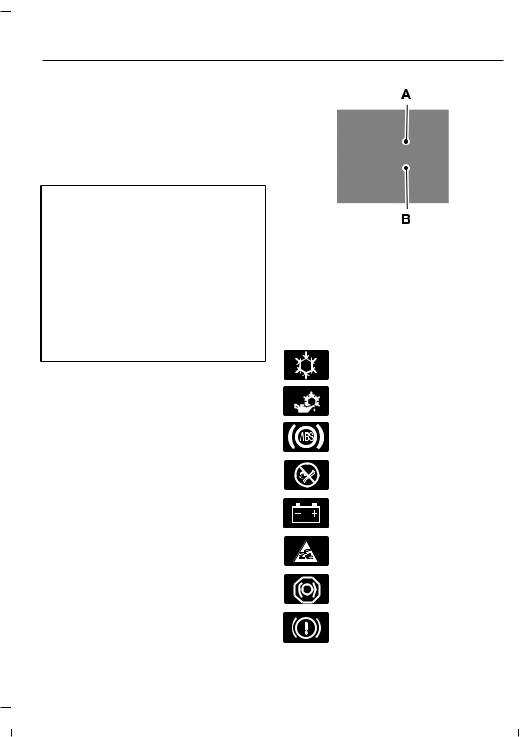
Introduction
ABOUT THIS MANUAL
Thank you for choosing Ford. We recommend that you take some time to get to know your vehicle by reading this manual. The more that you know about your vehicle, the greater the safety and pleasure you will get from driving it.
 WARNING: Driving while distracted can result in loss of vehicle control, crash and injury. We strongly recommend that you use extreme caution when using any device that may take your focus off the road. Your primary responsibility is the safe operation of your vehicle. We recommend against the use of any hand-held device while driving and encourage the use of voice-operated systems when possible. Make sure you are aware of all applicable local laws that may affect the use of electronic devices while driving.
WARNING: Driving while distracted can result in loss of vehicle control, crash and injury. We strongly recommend that you use extreme caution when using any device that may take your focus off the road. Your primary responsibility is the safe operation of your vehicle. We recommend against the use of any hand-held device while driving and encourage the use of voice-operated systems when possible. Make sure you are aware of all applicable local laws that may affect the use of electronic devices while driving.
Note: This manual describes product features and options available throughout the range of available models, sometimes even before they are generally available. It may describe options not fitted to the vehicle you have purchased.
Note: Some of the illustrations in this manual may show features as used in different models, so may appear different to you on your vehicle.
E154903
A Right-hand side.
BLeft-hand side.
SYMBOLS GLOSSARY
These are some of the symbols you may see on your vehicle.
Air conditioning system
Air conditioning system lubricant type
Anti-lock braking system
Avoid smoking, flames or sparks
Note: Always use and operate your vehicle in line with all applicable laws and regulations.
Note: Pass on this manual when selling your vehicle. It is an integral part of your vehicle.
This manual may qualify the location of a component as left-hand side or right-hand side. The side is determined when facing forward in the seat.
7
Battery
Battery acid
Brake fluid - non petroleum based
Brake system
http://carownersmanuals2Mus ang (CZG) Can d /United States of America, Vehicles Built From: 14-05- 018,.enUSA,com/Edition date: 201804, First-Printing

Introduction
Brake system
Cabin air filter
Check fuel cap
Child safety door lock or unlock
Child seat lower anchor
Child seat tether anchor
Cruise control
E71340
Do not open when hot
Engine air filter
Engine coolant
Engine coolant temperature
Engine oil
Explosive gas
Fan warning
Fasten seatbelt
8
Flammable
Front airbag
Front fog lamps
Fuel pump reset
Fuse compartment
Hazard flashers
Heated rear window
Windshield defrosting system
Interior luggage compartment release
Jack
Keep out of reach of children
Lighting control
Low tire pressure warning
Maintain correct fluid level
Note operating instructions
Mustang (CZG) Canada/United States of America, Vehicles Built From: 14-05-2018, enUSA, Edition date: 201804, First-Printing
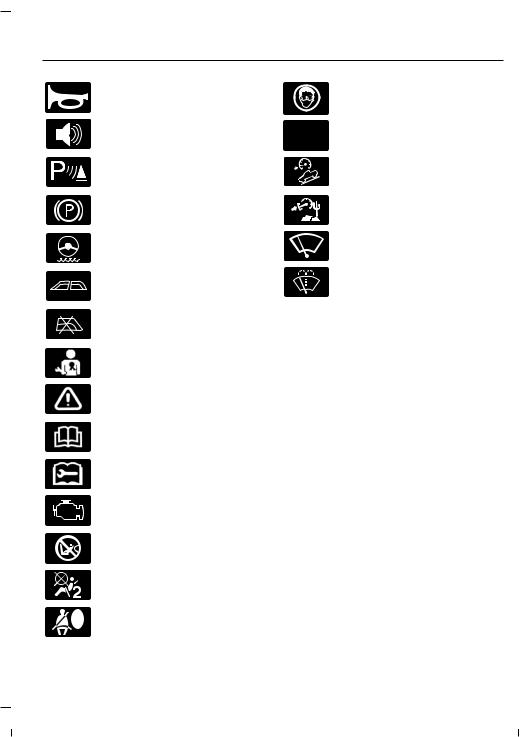
Introduction
Horn control
Panic alarm
Parking aid
E139213
Parking brake
Power steering fluid
Power windows front/rear
Power window lockout
Requires registered technician
Safety alert
See Owner's Manual
See Service Manual
Service engine soon
Passenger airbag activated
Passenger airbag deactivated
Side airbag
Shield the eyes
 Stability control
Stability control
Hill descent control
Trail control
Windshield wiping system
Windshield wash and wipe
DATA RECORDING
Service Data Recording
Service data recorders in your vehicle are capable of collecting and storing diagnostic information about your vehicle. This potentially includes information about the performance or status of various systems and modules in the vehicle, such as engine, throttle, steering or brake systems. In order to properly diagnose and service your vehicle, Ford Motor Company (Ford of Canada in Canada), and service and repair facilities may access or share among them vehicle diagnostic information received through a direct connection to your vehicle when diagnosing or servicing your vehicle. Additionally, Ford Motor Company (Ford of Canada, in Canada) may, where permitted by law, use vehicle diagnostic information for vehicle improvement or with other information we may have about you, (for example, your contact information), to offer you products or services that may interest you. Data may be provided to our service providers such
9
http://carownersmanuals2Mus ang (CZG) Can d /United States of America, Vehicles Built From: 14-05- 018,.enUSA,com/Edition date: 201804, First-Printing

Introduction
as part suppliers that may help diagnose malfunctions, and who are similarly obligated to protect data. We retain this data only as long as necessary to perform these functions or to comply with law. We may provide information where required in response to official requests to law enforcement or other government authorities or third parties acting with lawful authority or court order, and such information may be used in legal proceedings. For U.S. only (if equipped), if you choose to use connected apps and services, such as SYNC Vehicle Health Report or MyFord Mobile App, you consent that certain diagnostic information may also be accessed electronically by Ford Motor Company and Ford authorized service facilities, and that the diagnostic information may be used to provide services to you, personalizing your experience, troubleshoot, and to improve products and services and offer you products and services that may interest you, where permitted by law. For Canada only, for more information, please review the Ford of Canada privacy policy at www.ford.ca, including our U.S. data storage and use of service providers in other jurisdictions who may be subject to legal requirements in Canada, the United States and other countries applicable to them, for example, lawful requirements to disclose personal information to governmental authorities in those countries. See SYNC™ (page 321).
Event Data Recording
This vehicle is equipped with an event data recorder. The main purpose of an event data recorder is to record, in certain crash or near crash-like situations, such as an airbag deployment or hitting a road obstacle;
this data will assist in understanding how a vehicle’s systems performed. The event data recorder is designed to recorddatarelatedtovehicledynamics and safety systems for a short period of time, typically 30 seconds or less.
The event data recorder in this vehicle is designed to record such data as:
•Howvarioussystemsinyourvehicle were operating;
•Whether or not the driver and passenger safety belts were buckled/fastened;
•How far (if at all) the driver was depressing the accelerator and/or the brake pedal; and
•How fast the vehicle was traveling; and
•Where the driver was positioning the steering wheel.
This data can help provide a better understandingofthecircumstancesin which crashes and injuries occur.
Note: Event data recorder data is recorded by your vehicle only if a non-trivialcrashsituationoccurs;nodata is recorded by the event data recorder under normal driving conditions and no personal data or information (e.g.,name, gender, age, and crash location) is recorded (see limitations regarding 911 Assist and Traffic, directions and Information privacy below). However, parties, such as law enforcement, could combine the event data recorder data with the type of personally identifying data routinely acquired during a crash investigation.
To read data recorded by an event data recorder,specialequipmentisrequired, and access to the vehicle or the event data recorder is needed. In addition to the vehicle manufacturer, other parties, such as law enforcement, that havesuchspecialequipment,canread
10
Mustang (CZG) Canada/United States of America, Vehicles Built From: 14-05-2018, enUSA, Edition date: 201804, First-Printing

Introduction
the information if they have access to the vehicle or the event data recorder. Ford Motor Company and Ford of Canada do not access event data recorderinformationwithoutobtaining consent,unlesspursuanttocourtorder or where required by law enforcement, other government authorities or other third parties acting with lawful authority. Other parties may seek to access the information independently of Ford Motor Company and Ford of Canada.
Note: Including to the extent that any law pertaining to Event Data Recorders applies to SYNC or its features, please note the following: Once 911 Assist (if equipped) is enabled (set ON),911 Assist may, through any paired and connected cell phone, disclose to emergency services that the vehicle has been in a crash involving the deployment of an airbag or, in certain vehicles, the activation of the fuel pump shut-off. Certain versions or updates to 911 Assist may also be capable of being used to electronically or verbally provide to 911 operators the vehicle location (such as latitude and longitude), and/or other details about the vehicle or crash or personal information about the occupants to assist 911 operators to providethemostappropriateemergency services. If you do not want to disclose this information, do not activate the 911 Assist feature. See SYNC™(page 321).
Additionally, when you connect to Traffic, Directions and Information (if equipped, U.S. only), the service uses GPS technology and advanced vehicle sensors to collect the vehicle’s current location, travel direction, and speed (“vehicle travel information”), only to help provide you with the directions, traffic reports, or business searches that you request. If you do not want
11
Ford or its vendors to receive this information, do not activate the service. For more information, see Traffic, Directions and Information, Terms and Conditions. See SYNC™
(page 321).
PERCHLORATE
Certain components in your vehicle such as airbag modules, seatbelt pretensioners and remote control batteries may contain perchlorate material. Special handling may apply for service or vehicle end of life disposal.
For more information visit:
Web Address
www.dtsc.ca.gov/hazardouswaste/perchlorate
FORD CREDIT
US Only
Ford Credit offers a full range of financing and lease plans to help you acquire your vehicle. If you have financed or leased your vehicle through Ford Credit, thank you for your business.
We offer a number of convenient ways for you to contact us, and to manage your account.
Call 1-800-727-7000.
For more information about Ford Credit and access to Account Manager, go to www.ford.com/finance.
http://carownersmanuals2Mus ang (CZG) Can d /United States of America, Vehicles Built From: 14-05- 018,.enUSA,com/Edition date: 201804, First-Printing

Introduction
REPLACEMENT PARTS
RECOMMENDATION
We have built your vehicle to the highest standards using quality parts. We recommend that you demand the use of genuine Ford and Motorcraft parts whenever your vehicle requires scheduled maintenance or repair. You can clearly identify genuine Ford and Motorcraft parts by looking for the Ford, FoMoCo or Motorcraft branding on the parts or their packaging.
Scheduled Maintenance and
Mechanical Repairs
One of the best ways for you to make sure that your vehicle provides years of service is to have it maintained in line with our recommendations using parts that conform to the specifications detailed in this Owner’s Manual. Genuine Ford and Motorcraft parts meet or exceed these specifications.
Collision Repairs
We hope that you never experience a collision, but accidents do happen. Genuine Ford replacement collision parts meet our stringent requirements for fit, finish, structural integrity, corrosion protection and dent resistance. During vehicle development we validate that these parts deliver the intended level of protection as a whole system. A great way to know for sure you are getting this level of protection is to use genuine Ford replacement collision parts.
12
Warranty on Replacement Parts
Genuine Ford and Motorcraft replacement parts are the only replacement parts that benefit from a Ford Warranty. The Ford Warranty may not cover damage caused to your vehicle as a result of failed non-Ford parts. For additional information, refer to the terms and conditions of the Ford Warranty.
SPECIAL NOTICES
New Vehicle Limited Warranty
For a detailed description of what is covered and what is not covered by your vehicle’s New Vehicle Limited Warranty, see the Warranty Guide that is provided to you along with your Owner’s Manual.
Additional Warranty Information
Your vehicle carries the same warranty as other Ford models. This information is covered in its entirety in the Ford Warranty Guide. You can obtain warranty service for your vehicle at any authorized dealer nationwide.
We design and build our vehicles for our customers to drive as delivered from the factory. The Ford Warranty Guide discusses vehicle use and the installation of aftermarket parts and their effect on warranty coverage. See the Ford Warranty Guide for complete information.
Using your vehicle on a dedicated road course may result in degraded function and failure of major systems such as the engine, transmission and rear axle due to the overheating of these systems. If you intend to use your vehicle on a dedicated road course, we suggest that you equip your vehicle with racing-type coolers to protect these three systems.
Mustang (CZG) Canada/United States of America, Vehicles Built From: 14-05-2018, enUSA, Edition date: 201804, First-Printing
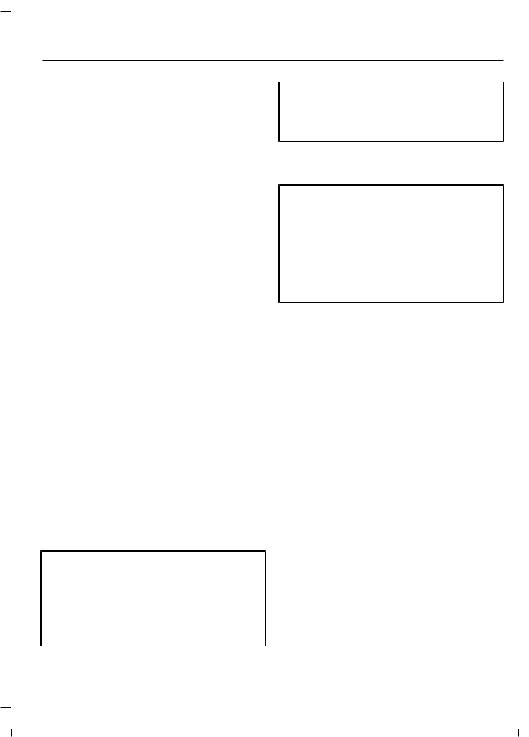
Introduction
In addition, if the vehicle is subjected to dedicated road course use, we recommend the following vehicle durability maintenance:
•Change your axle lubricant and friction modifier after the initial (first) hour of high-speed operation; thereafter change the axle lubricant and friction modifier every 12 hours (under these conditions).
•Change your transmission oil after each event where your vehicle is subjected to individual on-track sessions exceeding 15 minutes.
•Change your engine oil and filter after each event.
Additionally, perform a multi-point inspection on items specified in the scheduled maintenance section of this owner guide before and after dedicated road course use. See General Maintenance Information (page 419). See the vehicle service manual for removal and installation procedures. Replace with Genuine Ford and Motorcraft™ service parts as needed.
These actions may not necessarily protect your powertrain from damage in dedicated road course use. Subjecting your vehicle to dedicated road course use even with these proposed precautions may render repairs non-reimbursable under the warranty.
Special Instructions
For your added safety, your vehicle is fitted with sophisticated electronic controls.
 WARNING:You risk death or serious injury to yourself and others if you do not follow the instruction highlighted by the warning symbol. Failure to follow the specific warnings and instructions could result in personal injury.
WARNING:You risk death or serious injury to yourself and others if you do not follow the instruction highlighted by the warning symbol. Failure to follow the specific warnings and instructions could result in personal injury.
 WARNING: Never place front seat mounted rear-facing child or infant seats in front of an active passenger airbag.
WARNING: Never place front seat mounted rear-facing child or infant seats in front of an active passenger airbag.
On Board Diagnostics Data Link
Connector
 WARNING: Do not connect wireless plug-in devices to the data link connector. Unauthorized third parties could gain access to vehicle data and impair the performance of safety related systems. Only allow repair facilities that follow our service and repair instructions to connect their equipment to the data link connector.
WARNING: Do not connect wireless plug-in devices to the data link connector. Unauthorized third parties could gain access to vehicle data and impair the performance of safety related systems. Only allow repair facilities that follow our service and repair instructions to connect their equipment to the data link connector.
Your vehicle has an OBD Data Link Connector (DLC) that is used in conjunction with a diagnostic scan tool for vehicle diagnostics, repairs and reprogramming services. Installing an aftermarket device that uses the DLC during normal driving for purposes such as remote insurance company monitoring, transmission of vehicle data to other devices or entities, or altering the performance of the vehicle, may cause interference with or even damage to vehicle systems. We do not recommend or endorse the use of aftermarket plug-in devices unless approved by Ford. The vehicle Warranty will not cover damage caused by an aftermarket plug-in device.
13
http://carownersmanuals2Mus ang (CZG) Can d /United States of America, Vehicles Built From: 14-05- 018,.enUSA,com/Edition date: 201804, First-Printing

Introduction
MOBILE COMMUNICATIONS EQUIPMENT
 WARNING: Driving while distracted can result in loss of vehicle control, crash and injury. We strongly recommend that you use extreme caution when using any device that may take your focus off the road. Your primary responsibility is the safe operation of your vehicle. We recommend against the use of any hand-held device while driving and encourage the use of voice-operated systems when possible. Make sure you are aware of all applicable local laws that may affect the use of electronic devices while driving.
WARNING: Driving while distracted can result in loss of vehicle control, crash and injury. We strongly recommend that you use extreme caution when using any device that may take your focus off the road. Your primary responsibility is the safe operation of your vehicle. We recommend against the use of any hand-held device while driving and encourage the use of voice-operated systems when possible. Make sure you are aware of all applicable local laws that may affect the use of electronic devices while driving.
Using mobile communications equipment is becoming increasingly important in the conduct of business and personal affairs. However, you must not compromise your own or others’ safety when using such equipment. Mobile communications can enhance personal safety and security when appropriately used, particularly in emergency situations. Safety must be paramount when using mobile communications equipment to avoid negating these benefits. Mobile communication equipment includes, but is not limited to, cellular phones, pagers, portable email devices, text messaging devices and portable two-way radios.
EXPORT UNIQUE OPTIONS
For your particular global region, your vehicle may be equipped with features and options that are different from the features and options that are described in this Owner’s Manual. A market unique supplement may be supplied that complements this book. By referring to the market unique supplement, if provided, you can properly identify those features,
recommendations and specifications that are unique to your vehicle. This Owner’s Manual is written primarily for the U.S. and Canadian Markets. Features or equipment listed as standard may be different on units built for export. Refer to this Owner’s
Manual for all other required information and warnings.
14
Mustang (CZG) Canada/United States of America, Vehicles Built From: 14-05-2018, enUSA, Edition date: 201804, First-Printing

Environment
PROTECTING THE
ENVIRONMENT
You should play your part in protecting the environment. Correct vehicle usage and the authorized disposal of waste, cleaning and lubrication materials are significant steps toward this aim.
For details about Ford Motor Company'ssustainabilityprogressand initiatives visit:
Web Address
www.sustainability.ford.com
15
http://carownersmanuals2Mus ang (CZG) Can d /United States of America, Vehicles Built From: 14-05- 018,.enUSA,com/Edition date: 201804, First-Printing

At a Glance
INSTRUMENT PANEL OVERVIEW
E250044
AAir vents.
BDirection indicators. See
DirectionIndicators (page 75).
CInstrument cluster. See
Instrument Cluster (page 81).
DWiper lever. See Wipers and Washers (page 69).
EInformation and entertainment display. See General Information (page 338).
FAudio unit. See Audio System (page 311).
GDrive control switches. See
Drive Control (page 186).
16
HClimate controls. See Climate Control (page 109).
IClimate controlled seats. See
Climate Controlled Seats
(page 122).
JHazard flasher switch. See
Hazard Flashers (page 206).
KKeyless start button. See
Keyless Starting (page 130).
LInformation display controls. See
Information Display Control
(page 68).
MSteering wheel adjustment. See
AdjustingtheSteeringWheel
(page 66).
NHorn.
Mustang (CZG) Canada/United States of America, Vehicles Built From: 14-05-2018, enUSA, Edition date: 201804, First-Printing

At a Glance
OCruise control switches. See
Cruise Control (page 165).
PAudio control. See Audio Control (page 66).
QLuggage compartment release button. See Locking and Unlocking (page 58).
RLighting control. See Lighting (page 71).
17
http://carownersmanuals2Mus ang (CZG) Can d /United States of America, Vehicles Built From: 14-05- 018,.enUSA,com/Edition date: 201804, First-Printing

Child Safety
GENERAL INFORMATION
See the following sections for directions on how to properly use safety restraints for children.
 WARNING: Always make sure your child is secured properly in a device that is appropriate for their height, age and weight. Child safety restraints must be bought separately from your vehicle. Failure to follow these instructions and guidelines may result in an increased risk of serious injury or death to your child.
WARNING: Always make sure your child is secured properly in a device that is appropriate for their height, age and weight. Child safety restraints must be bought separately from your vehicle. Failure to follow these instructions and guidelines may result in an increased risk of serious injury or death to your child.
 WARNING: All children are shaped differently. The National Highway Traffic Safety Administration and other safety organizations,base their recommendations for child restraints on probable child height, age and weight thresholds, or on the minimum requirements of the law. We recommend that you check with a NHTSA Certified Child Passenger Safety
WARNING: All children are shaped differently. The National Highway Traffic Safety Administration and other safety organizations,base their recommendations for child restraints on probable child height, age and weight thresholds, or on the minimum requirements of the law. We recommend that you check with a NHTSA Certified Child Passenger Safety
18
Technician (CPST) to make sure that you properly install the child restraint in your vehicle and that you consult your pediatrician to make sure you have a child restraint appropriate for your child. To locate a child restraint fitting station and CPST, contact NHTSA toll free at 1-888-327-4236 or go to www.nhtsa.dot.gov. In Canada, contact Transport Canada toll free at 1-800-333-0371 or go to www.tc.gc.ca to find a Child Car Seat Clinic in your area. Failure to properly restrain children in child restraints made especially for their height, age and weight, may result in an increased risk of serious injury or death to your child.
 WARNING: On hot days, the temperature inside the vehicle can rise very quickly. Exposure of people or animals to these high temperatures for even a short time can cause death or serious heat related injuries, including brain damage. Small children are particularly at risk.
WARNING: On hot days, the temperature inside the vehicle can rise very quickly. Exposure of people or animals to these high temperatures for even a short time can cause death or serious heat related injuries, including brain damage. Small children are particularly at risk.
Mustang (CZG) Canada/United States of America, Vehicles Built From: 14-05-2018, enUSA, Edition date: 201804, First-Printing

Child Safety
Recommendations for Safety Restraints for Children
Child
Infants or toddlers
Small children
Child size, height, weight, or age |
Recommended restraint |
|
type |
Children weighing 40 lb (18 kg) or less |
Use a child safety seat |
(sometimes called an |
|
(generally age four or younger). |
infant carrier, convertible |
|
seat, or toddler seat). |
Children who have outgrown or no longer |
|
properly fit in a child safety seat (gener- |
|
ally children who are less than 4 ft. 9 in. |
Use a belt-positioning |
(1.45 m) tall, are greater than age four |
|
and less than age 12, and between 40 lb |
booster seat. |
(18 kg) and 80 lb (36 kg) and upward to |
|
100 lb (45 kg) if recommended by your |
|
child restraint manufacturer). |
|
|
Children who have outgrown or no longer |
Use a vehicle safety belt |
|
properly fit in a belt-positioning booster |
having the lap belt snug |
Larger children |
seat (generally children who are at least |
and low across the hips, |
4 ft. 9 in. (1.45 m) tall or greater than |
shoulder belt centered |
|
|
80 lb (36 kg) or 100 lb (45 kg) if recom- |
across the shoulder and |
|
mended by child restraint manufacturer). |
chest, and seatback |
|
|
upright. |
•You are required by law to properly use safety seats for infants and toddlers in the United States and Canada.
•Many states and provinces require that small children use approved booster seats until they reach age eight, a height of 4 feet 9 inches (1.45 meters) tall, or 80 lb (36 kg). Check your local and state or provincial laws for specific requirements about the safety of children in your vehicle.
•When possible, always properly restrain children 12 years of age and under in a rear seating position of your vehicle. Accident statistics suggest that children are safer when properly restrained in the rear seating positions than in a front seating position. See
Front Passenger Sensing System
(page 40).
INSTALLING CHILD RESTRAINTS
Child Seats
E142594
19
http://carownersmanuals2Mus ang (CZG) Can d /United States of America, Vehicles Built From: 14-05- 018,.enUSA,com/Edition date: 201804, First-Printing

Child Safety
Use a child safety seat (sometimes called an infant carrier, convertible seat, or toddler seat) for infants, toddlers, or children weighing 40 pounds (18 kilograms) or less (generally age four or younger).
Using Lap and Shoulder Belts
 WARNING: Airbags can kill or injure a child in a child seat. Never place a rear-facing child seat in front of an active airbag. If you must use a forward-facing child seat in the front seat, move the seat upon which the child seat is installed all the way back.
WARNING: Airbags can kill or injure a child in a child seat. Never place a rear-facing child seat in front of an active airbag. If you must use a forward-facing child seat in the front seat, move the seat upon which the child seat is installed all the way back.
 WARNING: Airbags can kill or injure a child in a child seat. Children 12 and under should be properly restrained in the rear seat whenever possible.
WARNING: Airbags can kill or injure a child in a child seat. Children 12 and under should be properly restrained in the rear seat whenever possible.
 WARNING:Depending on where you secure a child restraint, and depending on the child restraint design, you may block access to certain seatbelt buckle assemblies and LATCH lower anchors, rendering those features potentially unusable. To avoid risk of injury, occupants should only use seating positions where they are able to be properly restrained.
WARNING:Depending on where you secure a child restraint, and depending on the child restraint design, you may block access to certain seatbelt buckle assemblies and LATCH lower anchors, rendering those features potentially unusable. To avoid risk of injury, occupants should only use seating positions where they are able to be properly restrained.
When installing a child safety seat with combination lap and shoulder belts:
•Place the vehicle seat upon which the child seat will be installed in the upright position.
•Put the seatbelt in the automatic locking mode. See Step 5. This vehicle does not require the use of a locking clip.
Perform the following steps when installing the child seat with combination lap and shoulder belts:
Note: Although the child seat illustrated is a forward facing child seat, the steps are the same for installing a rear facing child seat.
E142528
1.Position the child safety seat in a seat with a combination lap and shoulder belt.
•Use the correct seatbelt buckle for that seating position.
•Insert the belt tongue into the proper buckle until you hear a snap and feel it latch. Make sure the tongue is securely fastened in the buckle.
•Keep the buckle release button pointing up and away from the safety seat, with the tongue between the child seat and the release button, to prevent accidental unbuckling.
E142529
20
Mustang (CZG) Canada/United States of America, Vehicles Built From: 14-05-2018, enUSA, Edition date: 201804, First-Printing

Child Safety
2.Pull down on the shoulder belt and then grasp the shoulder belt and lap belt together.
E142530
3.While holding the shoulder and lap belt portions together, route the tongue through the child seat according to the child seat manufacturer's instructions. Be sure the belt webbing is not twisted.
E142875
5.To put the retractor in the automatic locking mode, grasp the shoulder portion of the belt and pull downward until all of the belt is pulled out.
Note: The automatic locking mode is available on the front passenger and rear seats. This vehicle does not require the use of a locking clip.
6.Allow the belt to retract to remove slack. The belt will click as it retracts to indicate it is in the automatic locking mode.
7.Try to pull the belt out of the retractor to make sure the retractor is in the automatic locking mode (you should not be able to pull more belt out). If the retractor is not locked, unbuckle the belt and repeat Steps 5 and 6.
E142531
4.Insert the belt tongue into the proper buckle (the buckle closest to the direction the tongue is coming from) for that seating position until you hear a snap and feel the latch engage. Make sure the tongue is latched securely by pulling on it.
E142533
21
http://carownersmanuals2Mus ang (CZG) Can d /United States of America, Vehicles Built From: 14-05- 018,.enUSA,com/Edition date: 201804, First-Printing

Child Safety
8.Remove remaining slack from the belt. Force the seat down with extra weight, for example, by pressing down or kneeling on the child restraint while pulling up on the shoulder belt in order to force slack from the belt. This is necessary to remove the remaining slack that will exist once the extra weight of the child is added to the child restraint. It also helps to achieve the proper snugness of the child seat to your vehicle. Sometimes, a slight lean toward the buckle will additionally help to remove remaining slack from the belt.
9.Attach the tether strap (if the child seat is equipped).
E142534
10.Before placing the child in the seat, forcibly move the seat forward and back to make sure the seat is securely held in place. To check this, grab the seat at the belt path and attempt to move it side to side and forward and back. There should be no more than 1 inch (2.5 centimeters) of movement for proper installation.
We recommend checking with a NHTSA Certified Child Passenger Safety Technician to make certain the child restraint is properly installed. In Canada, check with Transport Canada for referral to a Child Car Seat Clinic.
Using Lower Anchors and Tethers for CHildren (LATCH)
 WARNING: Never attach two child safety seats to the same anchor. In a crash, one anchor may not be strong enough to hold two child safety seat attachments and may break, causing serious injury or death.
WARNING: Never attach two child safety seats to the same anchor. In a crash, one anchor may not be strong enough to hold two child safety seat attachments and may break, causing serious injury or death.
 WARNING:Depending on where you secure a child restraint, and depending on the child restraint design, you may block access to certain seatbelt buckle assemblies or LATCH lower anchors, rendering those features potentially unusable. To avoid risk of injury, occupants should only use seating positions where they are able to be properly restrained.
WARNING:Depending on where you secure a child restraint, and depending on the child restraint design, you may block access to certain seatbelt buckle assemblies or LATCH lower anchors, rendering those features potentially unusable. To avoid risk of injury, occupants should only use seating positions where they are able to be properly restrained.
 WARNING: The center of the rear seat is not designed as a seating position and is not equipped with seatbelts. The LATCH anchors were not designed to be used with a child seat in the center position and there is no tether anchor available at the center. Attempted use of the center as a seating position will increase the risk of injury or death in the event of a crash.
WARNING: The center of the rear seat is not designed as a seating position and is not equipped with seatbelts. The LATCH anchors were not designed to be used with a child seat in the center position and there is no tether anchor available at the center. Attempted use of the center as a seating position will increase the risk of injury or death in the event of a crash.
The LATCH system is composed of three vehicle anchor points: two lower anchors located where seat back and seat cushion meet (called the seat bight) and one top tether anchor located behind that seating position.
LATCH compatible child safety seats have two rigid or webbing mounted attachments that connect to the two lower anchors at the LATCH equipped seating positions in your vehicle. This type of attachment method eliminates the need to use seatbelts to attach the child seat,
22
Mustang (CZG) Canada/United States of America, Vehicles Built From: 14-05-2018, enUSA, Edition date: 201804, First-Printing

Child Safety
however the seatbelt can still be used to attach the child seat. For forward-facing child seats, the top tether strap must also be attached to the proper top tether anchor, if a top tether strap has been provided with your child seat.
Attach LATCH lower attachments of the child seat only to the anchors shown.
Combining Seatbelt and LATCH Lower Anchors for Attaching Child Safety Seats
When used in combination, either the seatbelt or the LATCH lower anchors may be attached first, provided a proper installation is achieved. Attach the tether strap afterward, if included with the child seat.
Using Tether Straps
E174449
Your vehicle has LATCH lower anchors for child seat installation at the seating positions marked with the child seat symbol.
E187773
The LATCH anchors are located at the rear section of the rear seat between the cushion and seatback below the symbols as shown. Follow the child seat manufacturer's instructions to properly install a child seat with LATCH attachments. Follow the instructions on attaching child safety seats with tether straps.
23
Many forward-facing child safety seats include a tether strap which extends from the back of
the child safety seat and hooks to an anchoring point called the top tether anchor. Tether straps are available as an accessory for many older safety seats.
Contact the manufacturer of your child seat for information about ordering a tether strap, or to obtain a longer tether strap if the tether strap on your safety seat does not reach the appropriate top tether anchor in your vehicle.
Once the child safety seat has been installed using either the seatbelt, the lower anchors of the LATCH system, or both, you can attach the top tether strap.
The tether strap anchors in your vehicle are in the following positions (shown from top view):
http://carownersmanuals2Mus ang (CZG) Can d /United States of America, Vehicles Built From: 14-05- 018,.enUSA,com/Edition date: 201804, First-Printing

Child Safety
E174399
Perform the following steps to install a child safety seat with tether anchors:
For coupe:
Note: If you install a child seat with rigid LATCH attachments, do not tighten the tether strap enough to lift the child seat off your vehicle seat cushion when the child is seated in it. Keep the tether strap just snug without lifting the front of the child seat. Keeping the child seat just touching your vehicle seat gives the best protection in a severe crash.
1.Route the tether strap over the top of the seatback.
E174400
E174401
4.Clip the tether strap to the anchor as shown.
5.Tighten the child safety seat tether strap according to the manufacturer's instructions. If your child restraint system is equipped with a tether strap, and the child restraint manufacturer recommends its use, we also recommend its use.
If the safety seat is not anchored properly, the risk of a child being injured in a crash greatly increases.
For convertible:
Note: For easier access, attach the tether with the convertible top up.
1.Route the child safety seat tether strap over the top of the seatback.
2.Locate the correct anchor for the selected seating position.
3.Open the tether anchor cover.
24
Mustang (CZG) Canada/United States of America, Vehicles Built From: 14-05-2018, enUSA, Edition date: 201804, First-Printing
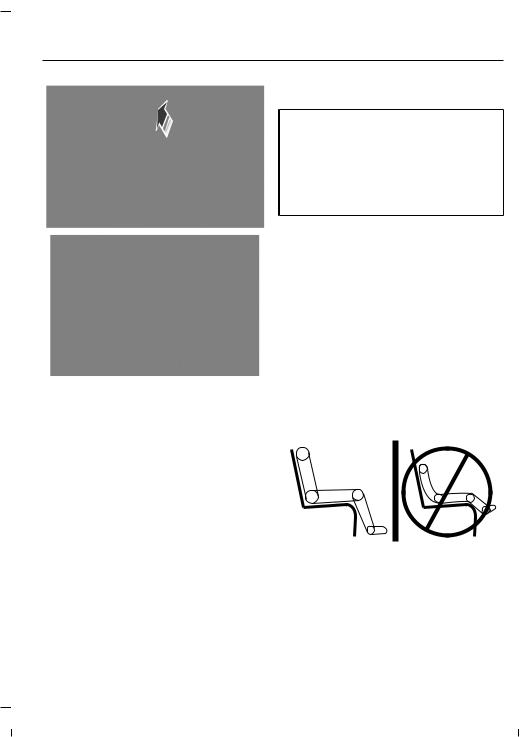
Child Safety
E185416
2.Access the tether anchors located behind the seatback.
3.Remove the tether anchor cap.
4.Clip the tether strap to the anchor.
5.Tighten the child safety seat tether strap according to the manufacturer’s instructions.
If the safety seat is not anchored properly, the risk of a child being injured in a crash greatly increases.
If your child restraint system is equipped with a tether strap, and the child restraint manufacturer recommends its use, we also recommend its use.
25
BOOSTER SEATS
 WARNING: Do not put the shoulder section of the seatbelt or allow the child to put the shoulder section of the seatbelt under their arm or behind their back. Failure to follow this instruction could reduce the effectiveness of the seatbelt and increase the risk of injury or death in a crash.
WARNING: Do not put the shoulder section of the seatbelt or allow the child to put the shoulder section of the seatbelt under their arm or behind their back. Failure to follow this instruction could reduce the effectiveness of the seatbelt and increase the risk of injury or death in a crash.
Use a belt-positioning booster seat for children who have outgrown or no longer properly fit in a child safety restraint (generally children who are less than 57 in (1.45 m) tall, are greater than age 4 and less than age 12, and between 40 lb (18 kg) and 80 lb (36 kg) and upward to 100 lb (45 kg) if recommended by your child restraint manufacturer). Many state and provincial laws require that children use approved booster seats until they reach age eight, a height of 57 in (1.45 m) tall, or 80 lb (36 kg).
Booster seats should be used until you can answer YES to ALL of these questions when seated without a booster seat:
E142595
•Can the child sit all the way back against their vehicle seat backrest with knees bent comfortably at the edge of the seat cushion?
•Can the child sit without slouching?
http://carownersmanuals2Mus ang (CZG) Can d /United States of America, Vehicles Built From: 14-05- 018,.enUSA,com/Edition date: 201804, First-Printing

Child Safety
•Does the lap belt rest low across the hips?
•Is the shoulder belt centered on the shoulder and chest?
•Can the child stay seated like this for the whole trip?
Always use booster seats in conjunction with your vehicle lap and shoulder belt.
Types of Booster Seats
E70710
E68924
•Backless booster seats
If your backless booster seat has a removable shield, remove the shield. If a vehicle seating position has a low seat backrest or no head restraint, a backless booster seat may place your child's head (as measured at the tops of the ears) above the top of the seat. In this case, move the backless booster to another seating position with a higher seat backrest or head restraint and lap and shoulder belts, or consider using a high back booster seat.
26
•High back booster seats
If, with a backless booster seat, you cannot find a seating position that adequately supports your child's head, a high back booster seat would be a better choice.
Children and booster seats vary in size and shape. Choose a booster that keeps the lap belt low and snug across the hips, never up across the stomach, and lets you adjust the shoulder belt to cross the chest and rest snugly near the center of the shoulder. The following drawings compare the ideal fit (center) to a shoulder belt uncomfortably close to the neck and a shoulder belt that could slip off the shoulder. The drawings also show how the lap belt should be low and snug across the child's hips.
Mustang (CZG) Canada/United States of America, Vehicles Built From: 14-05-2018, enUSA, Edition date: 201804, First-Printing
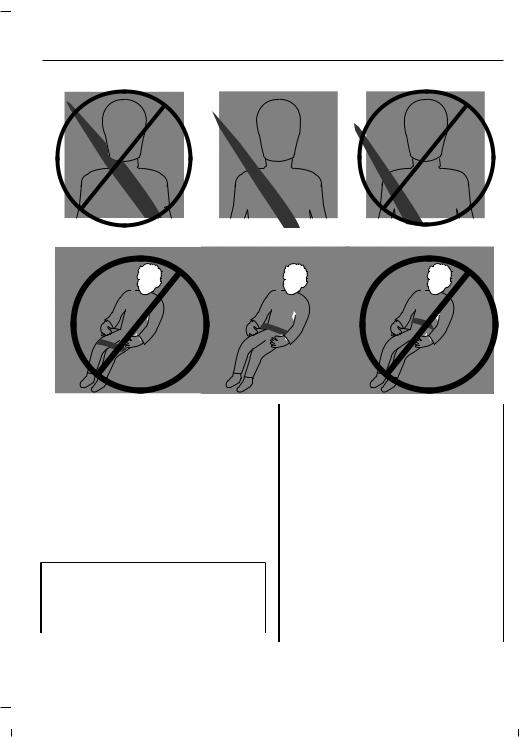
Child Safety
E142596
E142597
If the booster seat slides on the vehicle seat upon which it is being used, placing a rubberized mesh sold as shelf or carpet liner under the booster seat may improve this condition. Do not introduce any item thicker than this under the booster seat. Check with the booster seat manufacturer's instructions.
CHILD RESTRAINT
POSITIONING
 WARNING: Do not place a rearward facing child restraint in front of an active airbag. Failure to follow this instruction could result in personal injury or death.
WARNING: Do not place a rearward facing child restraint in front of an active airbag. Failure to follow this instruction could result in personal injury or death.
 WARNING:Properly secure children 12 years old and under in a rear seating position whenever possible. If you are unable to properly secure all children in a rear seating position, properly secure the largest child on the front seat. If you must use a forward facing child restraint on the front seat, move the seat as far back as possible. Failure to follow these instructions could result in personal injury or death.
WARNING:Properly secure children 12 years old and under in a rear seating position whenever possible. If you are unable to properly secure all children in a rear seating position, properly secure the largest child on the front seat. If you must use a forward facing child restraint on the front seat, move the seat as far back as possible. Failure to follow these instructions could result in personal injury or death.
 WARNING: Always carefully follow the instructions and warnings provided by the manufacturer of any child restraint to determine if the restraint device is appropriate for your child's size, height, weight, or age. Follow the child restraint
WARNING: Always carefully follow the instructions and warnings provided by the manufacturer of any child restraint to determine if the restraint device is appropriate for your child's size, height, weight, or age. Follow the child restraint
27
http://carownersmanuals2Mus ang (CZG) Can d /United States of America, Vehicles Built From: 14-05- 018,.enUSA,com/Edition date: 201804, First-Printing
